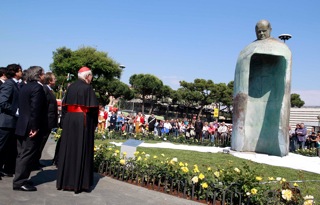 From Old World Swine, the long-ago promised
From Old World Swine, the long-ago promised
conclusion to my "But Is It Art?" series, Part One;
I titled this series "But, Is It Art?" because that was the question I
sought to answer regarding non-representational (purely abstract) art,
like the Robert Motherwell piece at left. My first instinct – my bias
early on – was to say that, no, it wasn’t really art. As I have
explained earlier, I have come to modify that position, and in the
process have come to a new appreciation of abstract art in its proper place.
I’m sure that in part my reaction against abstract art was due to
the particular kind of art education I slogged through as a young man.
The new broom of modernism had swept the academy clean, and it was made
plain again and again that only the dullest sort of hack artist would
bother to paint a straight, traditional portrait, still life or
landscape. The concept of seeking Beauty was actually derided, and one
poor grad student who let the term slip out during a critique was met
with snickers and the shaking of heads. She was done for.
In regard to non-representational art, we were trained not only to
see things that were not there, but to write papers about it… with
footnotes. We were all expected to take seriously the idea that a
canvas with a few lines and blobs of paint on it was as significant and
praiseworthy as Caravaggio’s Crucifixion of St. Peter. Not surprisingly, I don’t recall any student in the MFA program I went through who wasn’t simply adrift
as an artist. There was no sense of connection with history or
tradition beyond the last 100 years, or so, and indeed little sense of
connection even with one another. There was very little in the way of
technical help or instruction, and even less in terms of personal
artistic development, no cohesive approach or philosophy – no rules,
except "There are no rules". We were all making it up as we went along,
with more or less success.
It took quite a while for me to begin to see past this, to gain some
perspective. When I at last reached a point where I decided it was just
a matter of plain sanity to prefer beauty to ugliness or meaning to
emptiness, I was no longer painting at all, but was doing design and
illustration. It was no doubt due to my embrace of historical, orthodox
Christianity and the influence of writers like Tolkien, Chesterton and
C.S. Lewis that I came to think about the mystery of beauty at all. In
my new enthusiasm for tradition, meaning and beauty, I turned smartly
on my heels and completely dismissed non-objective art as a fraud and
the last refuge of talentless duffers.
But I digress.
In my next post I will give what I consider to be the strengths of
modern abstraction and talk about in what contexts and in what ways I
believe it does function well. In this post, though, I will
focus on why I believe non-objective art can not be placed in the same
category as the truly great works of art history.
Art is one of those magical, mysterious things – like writing and
music – that only humans do. It sets us apart from the animal world by
a gulf that is incomprehensibly wide.
There are two things – two fundamentally mysterious and magical
things – that traditional representational art does that
non-representational art does not do. The first is the most obvious;
representational art, well, represents something. It calls to
mind something that is not there, or that never existed except in the
imagination of the artist. It communicates symbolically in a way
analogous to writing. Writing is just ink on a page, figures of varied
kinds that we string together to make words, and then sentences and
presently we are drawn into a world, with its own people and events…
we are with Frodo and Sam on the slopes of Mount Doom, or tied to the
mast with Odysseus. One undeniable mystery of visual art is this power
to symbolically represent things that are not really there. It’s
something we may not often think about (because we are too busy doing
it), but the fact that I can draw a few lines and make you think of a
goat or a sailing ship is just indescribably awesome. It’s something
only we humans do… even cavemen knew that.
The second mysterious thing that traditional representational art often does can be related to the first, but they are not the
same; this is the breaking of the "picture plane", or the property of
taking the viewer past the surface of the painting and into an illusory
space. One can represent an object in a very flat and abstract way
(again, think of cave painting or modern road signs), but the ability
of the artist to create a believable space, with its own sense of
light, atmosphere and perspective adds a dimension to the experience
that is, again, powerful and mysterious. It gives the viewer the
sensation that they could reach past the frame and into the painting.
Most often they see past the surface of the picture without thinking about it. That’s magic. Alice through the looking glass.
These two properties are so fundamental and potent that they could very nearly be the definition of what fine visual art really is.
Without them, what is left are the merely formal aspects of visual
art… composition, color harmony, texture, etc… all important
things, but by themselves inadequate to move the viewer in anything like the way representational art can.
Now, there is a line of thought that holds that symbolic
representation and the illusion of form and space are irrelevant to the
appreciation of visual art, or even that such things get in the way,
which to me is exactly like saying "That could have been a great novel,
if not for all those characters, locations and plot developments
getting in the way", as if the true essence of a novel were in formal
concepts like "paragraphs" or "grammar".
The formal aspects of art are very significant, and can be
appreciated and admired for their own strengths, but there’s one
problem with that way of thinking; every great novel and every great
work of art possesses these formal strengths and uses them to great
effect anyway… and in addition also provides the kind
of narrative and symbolic communication that gives meaning to the
whole. In other words, with any great work of visual art, you get the
symbolic communication, the illusion and the brilliant use of the formal aspects (like composition, color, texture, etc…) thrown in, so the experience of traditional, representational art is much more comprehensive, making use of all the strengths of abstract art, but in service to the substantive mysteries of symbolism and illusion. The great thing about, say, a Sargent portrait is how a dash of paint
can function so completely, powerfully and simultaneously as both a vital and evocative bit of brushwork and
as a totally believable reflection on the bridge of a nose or the curve
of a shoulder. We see it as one, then the other, then both at once. The
passage resonates with the energy of this meaningful dichotomy.
The point being that if you’re going to toss out
representation and illusion to begin with, you had better have
something pretty damned powerful up your sleeve to give meaning to the
formal properties of the piece… that is if you’re after fine art.
There is another way of thinking that says that visual art shouldn’t
be compared to the concrete symbolism of writing, but rather to the
abstract patterns of music. Being wholly ignorant of the subject, I
will not even try to write in any meaningful way about how music works,
how it engages the emotions, but I will say that art, music, writing,
dance, etc… all enter the mind and move the human consciousness in
very different ways. Art is not meant to affect us just as music does,
or one of them would be redundant. In a similar way, it would be a
mistake to push the analogy of art to writing too far. Fine art can be a great deal more like visual poetry than straight visual story telling.
There certainly can be a very musical sense of rhythm, texture and mood
to a piece of visual art, but the mystery and power of visual fine art
flows from its own spring and can’t be understood simply and solely as
visual music.
There is a kind of art that functions something like visual music,
though… decorative art, which figures large in the next (and final)
post.







